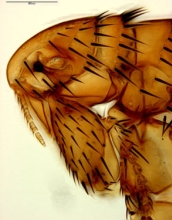Multimedia Gallery
Flea species Parapulex chephrensis
Flea species Parapulex chephrensis. This image was taken as part of a National Science Foundation-supported grant (DEB 96-15269), awarded in 1996 to Michael Whiting and George Byers of the Insect Molecular Genomics Lab at Brigham Young University. The purpose of the grant was to study Mesosphere, a small insect order of about 500 species, including scorpionflies and hangingflies, that are distributed throughout the world. [One of three related images. See Next Image.] To view images from other NSF-supported insect research at this lab, search for Insect Molecular Genomics Lab using the search engine in the Multimedia library.
More about this Image
The phylogenetic relationships among these insects are controversial and there is some evidence that the two families, currently placed in the Mecoptera order, should be assigned to their own orders. Whiting and Byers proposed that fleas (Siphonaptera--twisted-wing parasites), whose relationships to other insects has long remained a mystery, could actually be highly modified scorpionflies. Whiting and Byers investigated the phylogenetic relationships in Mecoptera by combining data compiled from studies on the biology, behavior and morphology of these insects with data from DNA sequences. The researchers collected sequence data and conducted morphological studies. The data was used to provide a robust estimate of mecopteran phylogeny using a range of computational techniques. The researchers hoped that this research would answer some long-standing questions of insect phylogeny and yield a significant revision of insect classification. The project would also provide an important base for evolutionary and developmental biologists who study these insects and their genes, and will serve as a conceptual and methodological platform for future work on the phylogeny of organisms.
In 2002, Whiting demonstrated that Siphonaptera is closely related to Boreidae (snow fleas), and more distantly related to Panorpidae (scorpionflies). Scorpionflies have well developed eyes and are highly visually oriented. Snow fleas, on the other hand, have only limited visual perception. These insects represent a unique opportunity to study the correlation between opsin gene evolution, eye structure and visual acuity. (Year of image: 2003)
Credit: Insect Molecular Genomics Lab, Brigham Young University
Images and other media in the National Science Foundation Multimedia Gallery are available for use in print and electronic material by NSF employees, members of the media, university staff, teachers and the general public. All media in the gallery are intended for personal, educational and nonprofit/non-commercial use only.
Images credited to the National Science Foundation, a federal agency, are in the public domain. The images were created by employees of the United States Government as part of their official duties or prepared by contractors as "works for hire" for NSF. You may freely use NSF-credited images and, at your discretion, credit NSF with a "Courtesy: National Science Foundation" notation.
Additional information about general usage can be found in Conditions.
Also Available:
Download the high-resolution JPG version of the image. (35 KB)
Use your mouse to right-click (Mac users may need to Ctrl-click) the link above and choose the option that will save the file or target to your computer.

